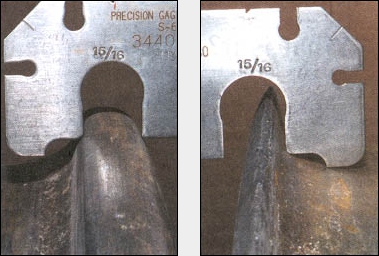
|
VOLUME THIRTY-ONE
|
NUMBER FIVE 2001
|
Derailment Averted

Left gauge
shows a normal flange; right gauge shows the flange on the
double-stack container car that was not registering on the transducer.
Winnipeg - When RTC Gerry Townsend
noticed a train carrying dangerous goods had twice gone through hot box detectors (HBD) on CPR's Ignace
subdivision showing an axle count of one less than the train consist indicated, he became concerned.
Each trackside, infra-red HBD system - used to detect hot wheels caused by sticky brakes,
overheated bearings, or dragging equipment - includes an axle count transducer mounted to the base of the rail
that is triggered each time a wheel flange passes over it.
Together with John Hudspeth, a signals and communications support specialist in the Calgary Network Management
Centre, Gerry poured over the data from the automatic equipment identification (AEI) system. Together they
determined that double-stack container car DTTX 620444 was the probable culprit.
They relayed the information to car planning specialist Tracy Harris, also in the NMC, and the train was
stopped in Winnipeg for a closer inspection.
A wheelset on the suspect car was found to be severely damaged, one wheel flange ground to an extremely thin
and dangerous condition.
The car was removed from the train and arrangements were made for a detailed investigation, in cooperation
with the car manufacturer, to discover the cause of the extreme wear. "Axle-count
discrepancies occur every day", said Mirek Wierucki, manager of train accident prevention. "But in
most cases it is a transducer problem and not a car problem. It is to the credit of these employees that they
followed up and ascertained that this was a car problem".
The situation has been discussed at pre-shift safety meetings with RTC's.
"We are seeking a better means of distinguishing between axle count discrepancies caused by transducer
problems and those caused by car problems", Mirek said.
This Canadian Pacific
Railway News article is copyright 2001 by the Canadian Pacific Railway and is reprinted here
with their permission. All photographs, logos, and trademarks are the property of the Canadian Pacific Railway
Company.
|
|